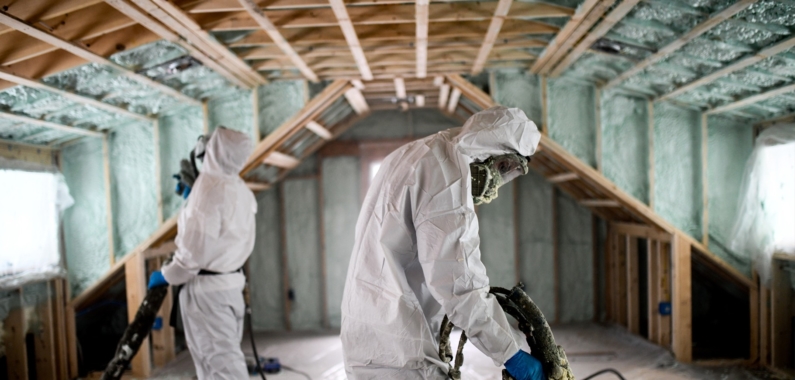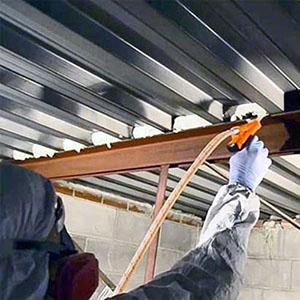The Environmental Impact of Spray Foam: Sustainability Considerations
The Environmental Impact of Spray Foam: Sustainability Considerations
Blog Article
Spray Foam: The Ultimate Remedy for Air Sealing and Insulation
Spray foam insulation has emerged as a leading solution for effective air sealing and thermal insulation, using an unique combination of homes that establish it besides standard approaches. Its capability to broaden and fill voids makes it specifically reliable in protecting against air leak, which can dramatically influence power effectiveness. Recognizing the complete scope of its benefits, installment processes, and comparisons with various other insulation types is essential for making informed choices. As we check out these aspects, the effects for both new constructions and retrofits come to be progressively significant. What variables should influence your choice?
What Is Spray Foam?
Spray foam is a functional insulation material that incorporates the principles of air sealing and thermal resistance to enhance power efficiency in buildings. Made up primarily of polyurethane or other comparable compounds, spray foam is applied as a fluid that increases upon contact with surfaces, developing a strong, continuous layer of insulation. This special home permits it to fill gaps, fractures, and gaps that traditional insulation materials may ignore, providing an exceptional air seal.
There are 2 major sorts of spray foam: open-cell and closed-cell. Open-cell spray foam is lighter and much more versatile, using superb sound absorption and a lower R-value per inch - Spray Foam. On the other hand, closed-cell spray foam is denser, offering a greater R-value, wetness resistance, and added architectural honesty to developing elements
The application procedure typically involves customized equipment, guaranteeing a smooth application that sticks to numerous substratums, including steel, concrete, and wood. This flexibility makes spray foam suitable for both new building and constructions and retrofitting existing structures. Its ability to develop an impermeable obstacle dramatically contributes to minimizing power usage and enhancing indoor air quality, thereby making it a recommended option among home builders and house owners alike.
Advantages of Spray Foam Insulation
One of the most substantial advantages of spray foam insulation is its remarkable capacity to develop a continual air obstacle, which efficiently minimizes power loss. Unlike conventional insulation products, spray foam broadens to fill voids and fractures, ensuring that air leakage is significantly lowered. This characteristic not just improves power effectiveness however also causes lower energy bills gradually.
In addition, spray foam insulation offers superior thermal resistance, contributing to an extra stable interior setting. Its high R-value per inch permits efficient insulation in constrained spaces, making it suitable for attics, walls, and crawl areas. Moreover, the moisture-resistant residential properties of spray foam help avoid mold and mildew and mold growth, promoting healthier living problems.
Another vital advantage of spray foam insulation is its sound-dampening top qualities (Spray Foam). It successfully lowers sound transmission in between areas, creating a quieter and more comfortable home setting. The resilience of spray foam additionally stands apart, as it does not droop or clear up over time, keeping its efficiency throughout its life expectancy
Just How Spray Foam Works
Understanding how spray foam insulation works is vital for valuing its effectiveness in air sealing and thermal resistance. Spray foam insulation consists of two main components: isocyanate and polyol resin. When these components are combined, they undertake a chain reaction that triggers the product to broaden rapidly, creating a thick foam that fills up spaces, cracks, and cavities.
As the foam broadens, it complies with surface areas, developing an impermeable seal that dramatically minimizes air infiltration. This particular makes spray foam insulation extremely reliable at protecting against drafts and wetness infiltration, which can cause energy loss and damages over time. In addition, the closed-cell variant of spray foam supplies exceptional thermal resistance as a result of its stiff framework, successfully minimizing warm transfer.
The unique properties of spray foam enable it to adapt irregular surface areas, ensuring thorough coverage and a seamless obstacle. Consequently, spray foam insulation not just boosts energy performance but likewise adds to improved indoor air high quality by lowering the accumulation of irritants and toxins. Eventually, recognizing the mechanics behind spray foam highlights its function as a premium choice for insulation and air sealing in both business and residential applications.
Installation Refine Review

Prior to installation, the room has to be sufficiently cleaned up and prepped, making certain that surface areas are without dampness, particles, and dirt. This action is critical due to the fact that impurities can endanger attachment and general efficiency. When the area is prepared, the application involves blending both parts of the spray foam, which broadens upon get in touch with and fills gaps properly.
Educated experts ought to conduct the installment, making use of customized devices to guarantee uniform insurance coverage and optimum density. Safety precautions, navigate to these guys consisting of using protective equipment and guaranteeing proper air flow, are imperative throughout this procedure. After application, the foam generally cures swiftly, developing a solid barrier that boosts power performance.
Contrasting Spray Foam to Conventional Insulation
When assessing insulation alternatives, spray foam insulation sticks out in contrast to standard materials such as fiberglass and cellulose. One of the key benefits of spray foam is its remarkable air sealing capabilities. Unlike fiberglass and cellulose, which can enable air infiltration, spray foam increases upon application, loading crevices and voids to produce an airtight seal. This causes enhanced power performance, as less heated or cooled down air escapes the home, bring about lower utility costs.
Furthermore, spray foam gives a greater R-value per inch than conventional insulation types, using even more reliable thermal resistance in a thinner account. This characteristic is particularly helpful in rooms with limited cavity depth. Spray foam is immune to dampness and mold and mildew growth, which can be a considerable Learn More Here issue with cellulose and fiberglass, especially in damp environments.
However, spray foam insulation generally carries a higher ahead of time price than its typical equivalents. House owners need to evaluate this initial investment versus long-lasting energy savings and efficiency advantages. Eventually, while both insulation types offer their function, spray foam emerges as an advanced option for contemporary insulation requirements, particularly in regards to air sealing and thermal efficiency.

Verdict
In summary, spray foam insulation web link represents an extremely reliable solution for achieving ideal air securing and thermal resistance. Its one-of-a-kind residential or commercial properties, including wetness resistance and audio dampening, make it ideal for numerous applications in both new constructions and retrofitting projects (Spray Foam). The initial prices might be greater contrasted to standard insulation materials, the long-lasting benefits, such as significant power financial savings and enhanced indoor air quality, justify the financial investment and emphasize its worth in contemporary structure practices.
Spray foam insulation has arised as a leading option for reliable air securing and thermal insulation, using an one-of-a-kind mix of residential properties that establish it apart from traditional approaches.Spray foam is a functional insulation material that combines the concepts of air sealing and thermal resistance to boost power efficiency in structures.When examining insulation options, spray foam insulation stands out in comparison to traditional products such as fiberglass and cellulose. Ultimately, while both insulation kinds serve their objective, spray foam emerges as an extra sophisticated solution for modern-day insulation needs, specifically in terms of air sealing and thermal performance.
In summary, spray foam insulation stands for a highly reliable solution for attaining optimal air securing and thermal resistance.
Report this page